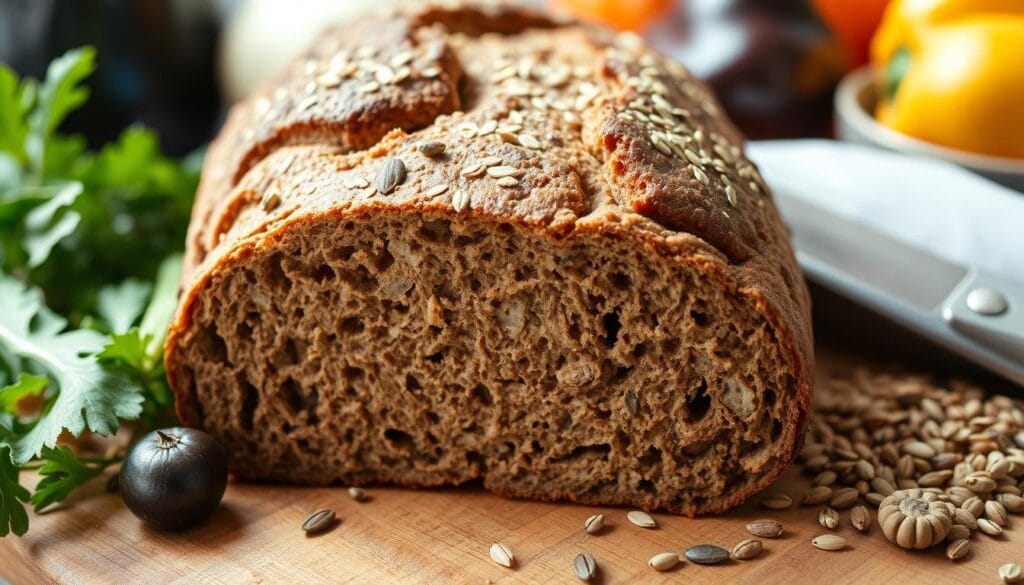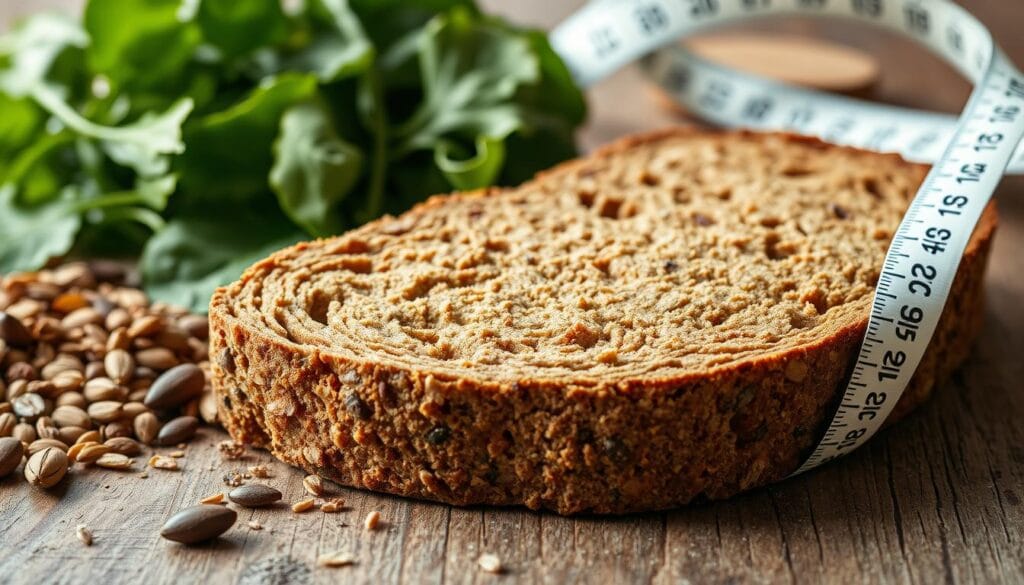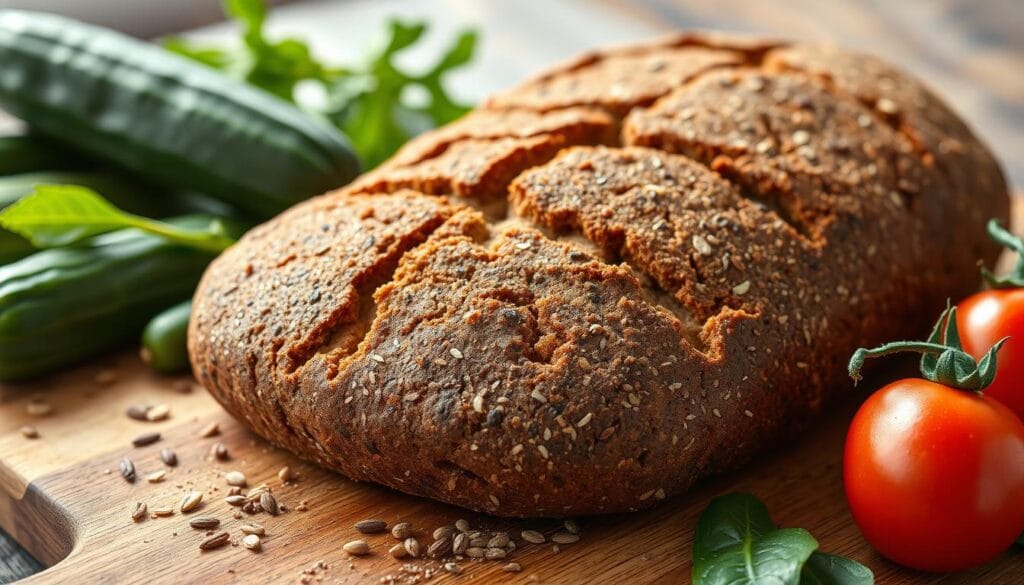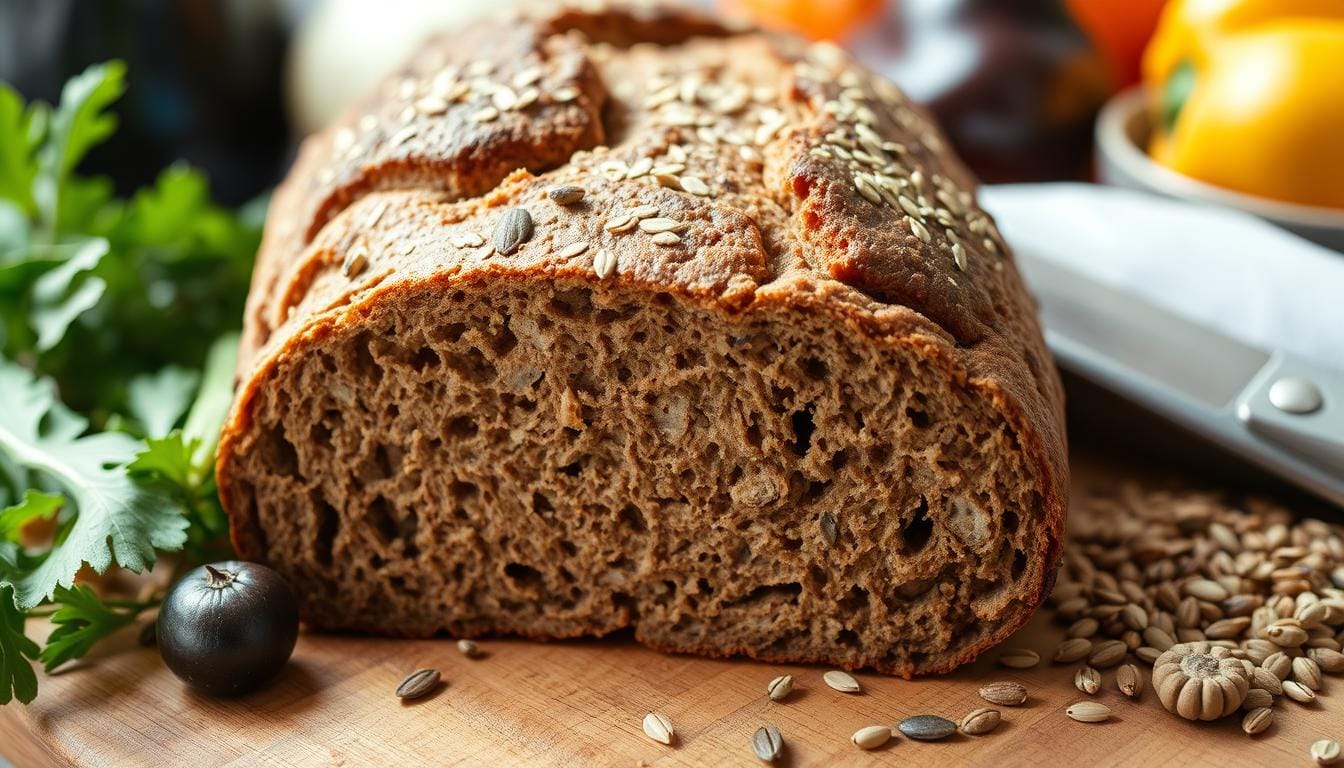Rye Bread Nutrition Info: A Healthier Alternative to White Bread
Looking for a nutritious bread option? Rye bread might be the answer. It’s packed with health benefits, making it a great choice for those who care about their health.
Rye bread stands out because it’s full of fiber and has a lower glycemic index. It also has more essential nutrients than white bread. This bread comes from places like Scandinavia and is known for its health benefits.

Table of Contents
Understanding Rye Bread Fundamentals
Rye bread has a rich history and a unique nutritional profile. It comes from Northern Europe and is a key part of Scandinavian and German diets. The bread’s qualities come from how it’s made and the flour used.
Origins and Production Methods
Rye bread is made from rye flour, which is different from wheat. Rye has less gluten, making the bread denser. The traditional way of making it involves sourdough fermentation. This makes the bread easier to digest and better for nutrient absorption.
Types of Rye Bread Available
There are many types of rye bread, like whole-grain, light, and dark rye. Each has its own taste and nutritional benefits. Artisan bakeries and specialty stores offer a wide range of high-quality rye bread.
What Makes Rye Bread Different
Rye bread is known for its high fiber content, especially pentosans. These fibers give the bread its unique texture and health benefits. Also, rye bread has a lower glycemic index than other breads. This means it helps keep blood sugar levels stable and makes you feel fuller longer.
“Rye bread is a nutritious and flavorful option that can add variety to your diet. Its unique properties make it a healthier alternative to traditional white bread.”
Rye Bread Nutrition Info
Rye bread is a nutritional powerhouse. A single slice, weighing 32 grams, contains about 83 calories, 15.5 grams of carbs, and 2.7 grams of protein. But there’s more to it.
It’s a great source of essential vitamins and minerals. You’ll find B vitamins, selenium, manganese, and iron. It also has lysine, an amino acid that’s often missing in other grains.
Compared to wheat bread, rye has a lower glycemic index. This means it’s digested slowly. It releases glucose into your bloodstream more steadily. This can help manage blood sugar and support weight management.
| Nutrient | Rye Bread (per slice) | Wheat Bread (per slice) |
|---|---|---|
| Calories | 83 | 80 |
| Carbs | 15.5 g | 14 g |
| Protein | 2.7 g | 5 g |
| Fat | 1.1 g | 1 g |
| Fiber | 1.9 g | 3 g |
Rye bread is a healthier alternative to traditional white bread. It’s great for managing weight, regulating blood sugar, or just for a more nutritious carb option. Definitely worth trying.
Essential Nutrients and Vitamins in Rye Bread
Rye bread is not just tasty and versatile. It’s also full of nutrients and vitamins that boost your health. It has key vitamins and minerals, plus beneficial compounds. This hearty bread offers many health benefits.
Key Vitamins and Minerals
Rye bread is rich in B vitamins like thiamine, riboflavin, and niacin. These vitamins help with energy, nerve function, and metabolism. It also has minerals like selenium, manganese, iron, and zinc. These minerals support many body functions.
Protein and Amino Acid Content
The protein in rye bread is high in lysine. Lysine is key for tissue repair, growth, and development. With 9g of protein per 100g, rye bread is a great protein source.
Beneficial Compounds and Antioxidants
Rye bread also has lignans, which are antioxidants. They may fight cancer. These plant compounds help fight off harmful free radicals and support cell health.
Eating rye bread can improve your health. It boosts energy, supports digestion, and heart health. Enjoy the health benefits of rye bread in your diet.
Fiber Content: The Digestive Health Champion
Rye bread, especially the whole grain types, has a lot of fiber. This fiber, called pentosans, is good for your health. It helps with digestion, lowers cholesterol, and aids in weight control.
Dietitians say to choose bread with two to three grams of fiber per serving. They suggest picking bread with whole wheat flour first to get enough fiber and vitamins. Rye bread, with about 1.9 grams of fiber per slice, is a better choice than white bread.
The fiber in rye bread helps slow digestion, prevent blood sugar spikes, increase satiety, and support gut health. It’s great for those trying to lose weight or manage diabetes. Its low glycemic index, around 71, helps control blood sugar.

Experts say to pick the healthiest breads like sourdough with whole wheat or rye flour, whole grain sourdough bread, 100% whole wheat bread, gluten-free bread, and pumpernickel bread. These offer more fiber and nutrients for better health.
Carbohydrates and Glycemic Impact
Rye bread is a healthier choice than white bread when it comes to carbs and blood sugar. It has a lower glycemic index, around 49. This means it raises blood sugar levels more slowly.
Blood Sugar Response
Rye bread’s complex carbs are key to its lower glycemic impact. Unlike white bread, rye’s carbs are digested and absorbed more slowly. This leads to a steady energy release, good for those with diabetes or who want to control blood sugar.
Insulin Regulation Benefits
Rye bread’s lower glycemic response means less insulin release. This is important for keeping blood sugar levels healthy. It helps avoid the big spikes and drops in blood sugar that high-glycemic foods cause.
Comparison with Other Bread Types
Rye bread gives you energy more steadily than white bread. Its complex carbs help keep energy levels up all day. Plus, it has lower calories and more fiber than white bread. This makes it a nutritious and low-calorie bread option.
“Incorporating whole grains like rye into the diet may be associated with lower body weight and reduced risk of obesity.”
Weight Management and Satiety Benefits
Rye bread can be a big help with weight management. It has a lot of fiber, which keeps you full for up to eight hours. This is much longer than white wheat bread. Feeling full for longer can help you eat fewer calories and keep a healthy weight.
The fiber in rye bread is why it keeps you full. It’s different from refined grains that can make your blood sugar spike and crash. Rye bread’s complex carbs digest slowly, giving you energy and keeping hunger away. This is great for people trying to lose weight or stop gaining it.
| Bread Type | Calories | Total Fat | Carbohydrates | Protein | Fiber |
|---|---|---|---|---|---|
| White Bread | 67 | 1g | 13g | 2g | 0.6g |
| Whole Wheat Bread | 92 | 2g | 17g | 3g | 2g |
| Rye Bread | 83 | 1g | 16g | 2.7g | 1.9g |
Adding rye bread to your diet can be a smart move for weight loss and health benefits. Its fiber and nutrients make you feel full and satisfied. This can lead to eating fewer calories and helping you manage your weight.

Gluten Content and Digestibility Factors
Rye bread has less gluten than wheat bread, which might be easier to digest for some. But, it’s not safe for people with celiac disease. They need to avoid all gluten.
Understanding Gluten Levels
Rye has less gluten because of its different nutritional makeup. It has about 1-2% gluten, unlike wheat’s 10-12%. This makes rye bread a good choice for those looking for a less gluteny option.
Digestive Tolerance Considerations
The sourdough process in rye bread makes it easier to digest. Lactic acid bacteria break down carbs and proteins. This makes nutrients more available to the body, helping with digestion.
But, how well you can digest rye bread varies. It depends on your sensitivity and any gluten issues. If you’re unsure, talk to a doctor before trying rye bread.
Knowing about gluten in rye bread and how it’s digested helps you decide if it’s right for you. Rye bread offers a healthier option compared to wheat bread.
Heart Health and Cholesterol Benefits
Eating rye bread can greatly benefit your heart. It’s full of dietary fiber, which helps manage cholesterol. Research shows rye bread might lower cholesterol more than wheat bread.
Rye bread’s fiber reduces bad LDL cholesterol and boosts good HDL cholesterol. This balance is key to a healthy heart. Rye also has magnesium and potassium, which improve heart function and blood pressure.
| Bread Type | Calories per Slice |
|---|---|
| Rye Bread | 83 |
| Whole Wheat Bread | 82 |
| Wonder Classic White Bread | 65 |
| Arnold Organic Rustic White Bread | 130 |
| Food for Life Ezekiel 4:9 Sprouted Bread | 80 |
| Food for Life Gluten-Free Brown Rice Bread | 110 |
Eating 28 to 30 grams of whole grains like rye daily can lower cholesterol. Also, having 1.5 servings of whole grains daily helps control blood sugar and insulin. This is good for your heart.
Rye bread is a heart-healthy choice compared to regular bread. Switching to rye can help improve your heart health and lower heart disease risk.
Storage and Shelf Life Advantages
Choosing the right bread for your home is important. Rye bread stands out because it stays fresh longer. This is thanks to its high pentosan content, which keeps it moist.
Rye bread can last months, not just days. This makes it a smart choice for saving money and reducing waste. It’s also packed with fiber, making it a healthier option.
“Rye bread has a longer shelf life compared to wheat bread due to its high pentosan content, which helps retain moisture. This property keeps the bread fresh and moist for extended periods, reducing food waste and providing a practical advantage for consumers.”
Rye bread is better for the planet and your wallet. It lasts longer, saving you time and money. It’s perfect for those who want to cut down on waste and enjoy a tasty, healthy bread.
How to Choose and Store Rye Bread
Choosing the right rye bread is key. Look for breads made with whole grain rye flour. Avoid those with added sugars or preservatives. These can lower the nutritional value and change the taste.
Quality Indicators
To find the best rye bread, check the label. Look for these signs:
- Whole grain rye flour as the first ingredient
- Minimal or no added sugars
- Limited preservatives and artificial additives
- A dense, chewy texture
- A deep, earthy aroma
Storage Best Practices
Proper storage keeps rye bread fresh and nutritious. Here’s how:
- Store in a cool, dry place, away from sunlight or heat.
- Use a paper or cloth bag for short-term storage to keep air in and moisture out.
- Freeze for longer storage. Wrap tightly in plastic or foil to avoid freezer burn.
- Thaw frozen rye bread at room temperature before serving for the best taste.
By following these tips, your rye bread will stay flavorful, nutritious, and healthy. It’s perfect for meals and snacks.
Conclusion
Rye bread is a nutritious and versatile choice. It has more fiber, less sugar, and lots of vitamins and minerals. Eating rye bread can help your digestion, weight, and heart health.
If you want to control your blood sugar, feel better, or try new breads, rye is great. It’s not just about taste. Knowing the rye bread nutrition info and health benefits of rye bread helps you choose wisely. This way, you get the rye bread vs white bread nutrition edge.
Choosing rye bread opens up new cooking possibilities. It’s good for your body and health. Try different rye breads and see how they can make your diet better and more balanced.
FAQ
What are the key nutritional benefits of rye bread compared to white bread?
Rye bread has more fiber, which is good for digestion. It also has less impact on blood sugar. Plus, it has more vitamins and minerals than white bread.
How does the calorie and carbohydrate content of rye bread compare to white bread?
A slice of rye bread (32 grams) has about 83 calories and 15.5 grams of carbs. White bread usually has more calories and carbs.
What essential vitamins and minerals are found in rye bread?
Rye bread is rich in B vitamins like thiamine, riboflavin, and niacin. It also has selenium, manganese, iron, and zinc.
How does the fiber content of rye bread compare to white bread?
Rye bread, especially whole grain, has more fiber than white bread. Its unique fibers help with digestion and offer extra health benefits.
What is the impact of rye bread on blood sugar and insulin levels?
Rye bread’s glycemic index is lower than white bread. This means it raises blood sugar levels slower. It can help manage diabetes by reducing insulin release.
How can rye bread aid in weight management?
Studies show rye bread can aid in weight management. Its high fiber content and ability to keep you full for up to eight hours are key benefits.
Is rye bread suitable for individuals with gluten sensitivities?
Rye has less gluten than wheat, making it easier to digest for some with gluten sensitivities. But, it’s not safe for those with celiac disease.
What are the heart health benefits of incorporating rye bread into your diet?
Eating rye bread can lower cholesterol and improve heart health. Its high fiber content is the main reason for these benefits.
What are the storage and shelf life advantages of rye bread compared to other bread types?
Rye bread lasts longer than wheat bread due to its high pentosan content. This keeps it fresh and moist for longer.
How can you identify and store high-quality rye bread?
Choose rye bread with whole grain rye flour as the first ingredient. Avoid added sugars or preservatives. Store it in a cool, dry place or freeze for longer.
DID OUR INFORMATION HELP YOU ?
There are no reviews yet. Be the first one to write one.

